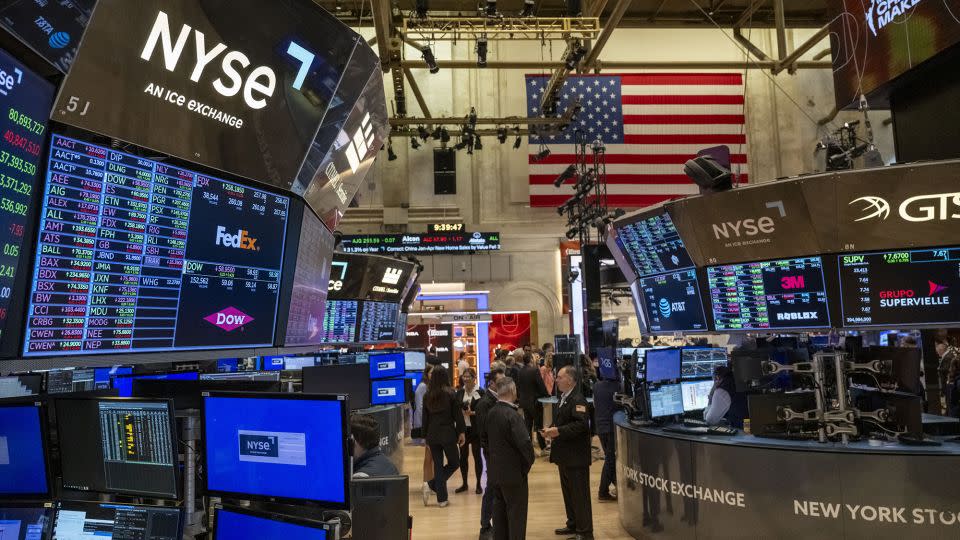Dow closes above 40,000 for first time ever

The Dow Jones Industrial Average closed above the 40,000 mark Friday for the first time in its 139-year history.
The blue-chip index initially crossed the key threshold early Thursday but ended that day lower.
Wall Street has been boosted in recent days by renewed hopes of rate cuts from the Federal Reserve that would loosen monetary conditions for consumers and businesses.
A report this week from the Bureau of Labor Statistics indicated that inflation has started to ease, potentially paving the way for the central bank to start implementing the rate cut that investors have been expecting since the start of the year.
“40,000 is a great milestone, but end of the day there isn’t much difference between 39,999 and 40k,” said Ryan Detrick, chief market strategist at Carson Group, in a note Friday. “Still, this is a great reminder of how far we’ve come. Think about how many people were talking about recessions and bear markets all of last year. Now we are once again back to new highs.”
“Investors who were patient and ignored all the scary headlines were once again rewarded, just as they have been throughout history,” he wrote.
All major indexes closed the week higher, but markets were mixed on Friday. The Dow rose 134 points, or 0.3%, to close at a record high of 40,003.59. This is the Dow’s fifth consecutive winning week.
The S&P 500 gained 0.1% and the Nasdaq Composite closed 0.1% lower.
Crossing 40,000
Crossing the 40,000 level doesn’t hold much practical value for investors, but it does catch the attention of the public and, some argue, it could help propel that optimistic sentiment beyond Wall Street.
“The Dow 40,000 milestone also shows how resilient the US economy has been, at a time where there was a plethora of calls for a recession,” said Art Hogan, chief market strategist at B. Riley Financial, in a recent note to CNN.
“The overarching importance of crossing these big round numbers is that it brings Wall Street news to Main Street, at least for a day. It also serves as an affirmation that corporate earnings are growing, and that investor confidence remains robust,” he said.
To many Americans, “the Dow” simply means the stock market. The index’s small cache of stocks — ranging from Microsoft to McDonald’s to Chevron — represents some of the largest companies in the nation and are widely held among retail and institutional investors alike.
A look back
Here are some important stops along the Dow’s road to 40,000:
Dow is formed: The first daily close, on May 26, 1896, was 40.94. The Dow did not get off to a good start, plunging 30% to an all-time low of 28.48 by August that year.
Dow 100: The Dow first closed in triple digits in January 1906. That marked an impressive rally for the average, which had hit an all-time low when Teddy Roosevelt was president. The Federal Reserve would not be created for seven more years.
Crash of 1929: The Dow fell 38 points on Oct. 28 and 31 more points the next day. That might not sound bad today, but it represented back-to-back declines of 13% and 12% of the Dow’s value. They are still two of the worst one-day percentage declines in the index’s history.
Dow 1,000: Nov. 14, 1972. Richard Nixon had just won reelection by taking 49 states. The Dow’s components, which had been unchanged for 13 years, included Woolworth, Eastman Kodak and International Nickel.
Crash of 1987: On Oct. 19, the Dow plunged 508 points, a 23% drop that is still the largest one-day percentage decline in history. A week later it took an 8% plunge. But the damage was short-lived: Within a year, the Dow was back to pre-crash levels.
Dow 10,000: March 29, 1999. The “irrational exuberance” of the tech bubble was in full swing as the Dow gained 1,000 points in less than a year to hit this benchmark. It gained 1,000 more points in just the next month.
A year later, the dot-com stock bubble burst, sending the Dow down nearly 30% by September 2001.
Meltdown of 2008-2009: The financial crisis caused the Dow to lose about half its value in less than a year, bottoming out to close at 6,547 on March 9, 2009. The worst day was Sept. 29, 2008, when the Dow lost what was then a record 778 points after Congress rejected a $700 billion bank bailout. The bailout was later approved.
Dow 15,000: May 7, 2013. As the economy continued to recover from the Great Recession, the Dow had one of the current bull market’s strongest periods. It crossed the 15,000 mark and finished the year up 26.5%, marking the best full-year performance of the current bull market. The Dow nearly matched that in 2017, rising 25%.
Dow 20,000: January 25, 2017. The stock market had enjoyed a nice run starting on the day after the 2016 election, with the Dow gaining nearly 10% as investors looked forward to lower taxes and less regulation under the Trump administration.
Dow 25,000: Jan. 4, 2018. The passage of the Trump tax cuts, especially the lowering of the corporate tax rate in December 2017, helped feed the quick move between 20,000 and 25,000.
Dow 30,000: Nov. 24, 2020: Covid sent the stock market plunging in the spring of 2020. But new hopes of a vaccine and the results of the presidential election ended an era of uncertainty on Wall Street, sending the stock market rolling once again.
Additional reporting by Chris Isidore
For more CNN news and newsletters create an account at CNN.com

 Yahoo Finance
Yahoo Finance 